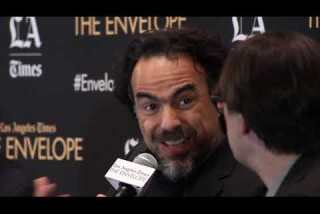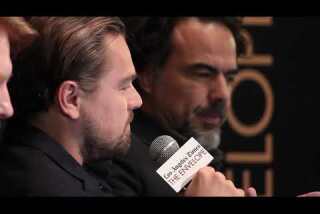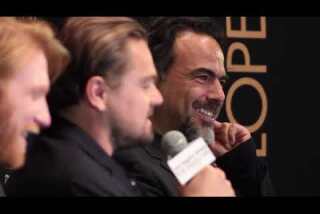Review: ‘The Revenant’ is a survival tale of beautiful, brute strength
Previous Alejandro G. Inarritu films such as “21 Grams,” “Babel” and the Oscar-winning “Birdman” have not lacked for pretension and self-importance, so it comes as something of a pleasant surprise, possibly even to the director himself, that what he’s come up with in “The Revenant” is a classic B picture fortified with all manner of Grade A resources.
It’s not that this inspired-by-fact story of celebrated scout and mountain man Hugh Glass and his battle for survival after being chewed up, spit out and left for dead by a particularly enraged bear completely avoids inflated moments, including but not limited to dreams, visions and folk wisdom of “the wind cannot affect a tree with strong roots” variety.
It’s, rather, that the combined exceptional work of star Leonardo DiCaprio and nonpareil cinematographer Emmanuel Lubezki create so much verisimilitude and beauty that it compels us to pay more attention to this glimpse of a dark, unsettling kill-or-be-killed world more than we otherwise would.
And points do go to Inarritu (who co-wrote the screenplay, loosely adapted from the Michael Punke novel, with Mark L. Smith) for being obsessive enough to insist on taking the cast and crew to the far corners of Alberta, Canada, and Tierra del Fuego in Argentina to ensure that locations would look and feel as remote and forbidding as they’re supposed to.
Though versions of Glass’ story have appeared on film before, most notably with the 1971 Richard Harris-starring “Man in the Wilderness,” it’s never been told with Inarritu’s insistence on a degree of authenticity that truly makes you feel present in the film’s time and place.
Watch Q&As with the ‘The Revenant’ cast and crew


Video: 'The Revenant': Limited shooting hours

'The Revenant': Attraction of the story

Video: 'The Revenant': Know what you're getting into

'The Revenant': Knowing a character's future

'The Revenant': Conditions affect performance

Video: 'The Revenant': The bear scene

'The Revenant': Agility of the story
That would be 1823 in a trackless area in what is now the state of South Dakota, where way-capable scout Glass (DiCaprio) is guiding a group of fur trappers employed by the Rocky Mountain Trading Co. under the command of Capt. Andrew Henry (Domhnall Gleeson).
After an opening dream sequence establishing that Glass has had a Native American wife, Lubezki’s gliding camera work circulates among the trappers camped at a riverside much as it moved in his Oscar-winning “Birdman.”
A sudden attack by the Arikara tribe, portrayed considerably more convincingly than this kind of sequence usually is, changes everything. Yes, the scene is violent, but unlike what we have to endure in Quentin Tarantino’s “The Hateful Eight,” the violence here and elsewhere in the film (including Glass crawling inside a disemboweled horse) is intrinsic to the situation and done with an absence of glee.
Most of the trappers are killed, and those who remain alive are persuaded by Glass to attempt an overland route back to their Fort Kiowa headquarters. The inevitable malcontent and naysayer is John Fitzgerald (Tom Hardy), a trapper from Texas whose impenetrable accent and surly disposition were not improved by having been unsuccessfully scalped back in the day.
Out alone hunting for food, Glass is attacked by that enormous incensed bear. Given that peerless ursine actor Bart the Bear has passed on, this totally convincing beast’s attack was created via a combination of stunt work and computer-generated images.
Alive but barely, Glass is carried in a litter for a while, but Capt. Henry, convinced that the scout’s death is near, leaves him behind with three men detailed to ensure that he gets a proper burial when the time comes. These are Glass’ son Hawk (Forrest Goodluck), a young Jim Bridger (Will Poulter) and that surly malcontent Fitzgerald.
Though it has the least dialogue of any of DiCaprio’s adult portrayals, Hugh Glass has to be one of the most powerful and convincing roles the actor has had, a part that’s taken hold of him to such an extent that it’s the equal of any of his four Oscar-nominated roles.
Full-bearded, capable of expressing rage with only his eyes, determined to survive to take revenge on those who did him dirty, even if he has to literally crawl to do it, DiCaprio makes us believe that he has the will and the skills to turn himself into a revenant, a man who has managed to come back from the dead with blood in his eye.
The actor’s great ally here is double Oscar-winning cinematographer Lubezki, who brilliantly captures the unnerving beauty of a virgin wilderness and Glass’ agonizing attempts to stay alive in it.
Shooting only with available light in frigid temperatures (a feat that bookends his work in the very hot Anza-Borrego Desert State Park in the unreleased “Last Days in the Desert”), Lubezki brings, as always, an extra layer of soulfulness and grace to his images.
The cinematographer can’t save “The Revenant’s” uncertain ending and unimpressive dialogue, but it’s not for want of trying. What Inarritu told The Times last year about his director of photography is apparently still true: “He loves to live on the edge. If failure is not a possibility, he doesn’t seem interested.”
------------
‘The Revenant’
MPAA rating: R, for strong frontier combat and violence, including gory images, a sexual assault, language and brief nudity.
Running time: 2 hours, 36 minutes
Playing: Landmark Theater, West Los Angeles, Arclight, Hollywood. In general release Jan. 8
More to Read
Only good movies
Get the Indie Focus newsletter, Mark Olsen's weekly guide to the world of cinema.
You may occasionally receive promotional content from the Los Angeles Times.











